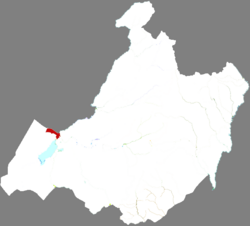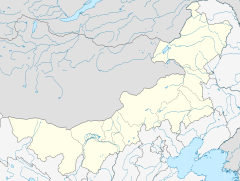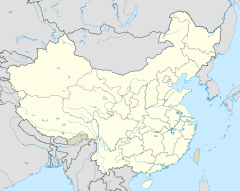Manzhouli
Manzhouli
满洲里市 · ᠮᠠᠨᠵᠤᠤᠷ ᠬᠣᠲᠠ | |
|---|---|
Clockwise from top: City center, Manzhouli Museum, Manzhouli Stadium, Beifang Market, Shiji Square | |
 Manzhouli in Hulunbuir | |
| Coordinates: 49°35′53″N 117°22′44″E / 49.598°N 117.379°E | |
| Country | China |
| Autonomous region | Inner Mongolia |
| Prefecture-level city | Hulunbuir |
| Municipal seat | Dongshan Subdistrict |
| Area | |
• Total | 732.4 km2 (282.8 sq mi) |
| Population (2020)[2] | |
• Total | 150,508 |
| • Density | 210/km2 (530/sq mi) |
| Time zone | UTC+8 (China Standard) |
| Postal code | 021400 |
| Area code | 0470 |
| Website | www |
| Manzhouli | |||||||||
|---|---|---|---|---|---|---|---|---|---|
| Chinese name | |||||||||
| Traditional Chinese | 滿洲里 | ||||||||
| Simplified Chinese | 满洲里 | ||||||||
| Postal | Manchouli | ||||||||
| |||||||||
| Mongolian name | |||||||||
| Mongolian Cyrillic | Манжуур хот | ||||||||
| Mongolian script | ᠮᠠᠨᠵᠤᠤᠷ ᠬᠣᠲᠠ | ||||||||
| |||||||||
| Russian name | |||||||||
| Russian | Маньчжурия | ||||||||
Manzhouli (Chinese: 满洲里; Mongolian: Манжуур хот; ᠮᠠᠨᠵᠤᠤᠷ ᠬᠣᠲᠠ) is a sub-prefectural city located in Hulunbuir prefecture-level city, Inner Mongolia Autonomous Region, China. Located on the border with Russia, it is a major land port of entry. It has an area of 696.3 square kilometres (268.8 sq mi) and a population of almost 250,000 (in 2010).
History
[edit]In ancient times the area was inhabited by the Donghu, Xiongnu, Xianbei, Khitan, Jurchen, Mongols and Manchu. During the decline of China's last dynasty, the Russian Empire forced the Qing (1644–1912) to cede Outer Manchuria in the 1858 Treaty of Aigun. That treaty made the Argun River, which originates in this area, the border between China and Russia.
In 1901, the China Far East Railway was completed in accordance with the Sino-Russian Secret Treaty of 1896, linking Siberia, Manchuria/northeast China, and the Russian Far East. A settlement then formed around Manchzhuriya Station, the first stop within Manchuria for Russians. It was the beginning of the modern city of Manzhouli and the name of Manzhouli came from Russian Манжули (Manzhuli).
In 1905, Manzhouli was designated a trading center, greatly boosting Manzhouli's growth. In 1908 the Manzhouli customs was set up. Under the Republic of China, Manzhouli (under the name Lubin [臚濱; Lúbīn; Lu2-pin1]) came under the jurisdiction of the province of Hsingan. In 1927, Manzhouli was designated as a city. Although with Hsingan and surrounding areas, Manzhouli came under Japanese control in 1931, and was part of the Empire of Manchuria from 1932 to 1945. It became part of Inner Mongolia under China from 1946.
In 1992, Manzhouli became one of the first land border cities opened up by the People's Republic of China. It has since experienced somewhat of a boom as a center of border trade between China and Russia.[3] In 2017, the Manzhouli Stadium opened. The football stadium has a capacity of 20,153.
Geography and climate
[edit]
Manzhouli is located in the western part of the Hulunbuir prefecture-level city. To the east, south and west it borders New Barag Left Banner and New Barag Right Banner, also in Hulunbuir, and Russia to the north, with which it shares a border 54 kilometres (34 mi) long. The Russian townlet of Zabaykalsk is situated immediately north of Abagaitu Islet and Manzhouli.
Manzhouli is located on the Hulunbuir grasslands. Lake Hulun to its immediate south is the PRC's fifth largest freshwater lake with an area of 2,600 square kilometers (1,000 sq mi) and an average depth of just 5 meters (16 ft).
Manzhouli has a semi-arid climate (Köppen (BSk), with temperatures in winter capable of plummeting below −40 °C (−40 °F). However, in each month there is more than 55% of possible sunshine, and over three-fourths of annual precipitation occurs from June to August.
| Climate data for Manzhouli, elevation 662 m (2,172 ft), (1991–2020 normals, extremes 1971–present) | |||||||||||||
|---|---|---|---|---|---|---|---|---|---|---|---|---|---|
| Month | Jan | Feb | Mar | Apr | May | Jun | Jul | Aug | Sep | Oct | Nov | Dec | Year |
| Record high °C (°F) | −0.6 (30.9) |
8.1 (46.6) |
18.4 (65.1) |
30.0 (86.0) |
34.3 (93.7) |
40.2 (104.4) |
40.5 (104.9) |
36.6 (97.9) |
34.0 (93.2) |
25.6 (78.1) |
11.5 (52.7) |
1.2 (34.2) |
40.5 (104.9) |
| Mean daily maximum °C (°F) | −17.4 (0.7) |
−11.3 (11.7) |
−1.6 (29.1) |
10.2 (50.4) |
19.0 (66.2) |
25.2 (77.4) |
27.2 (81.0) |
24.8 (76.6) |
18.1 (64.6) |
7.9 (46.2) |
−5.3 (22.5) |
−15.3 (4.5) |
6.8 (44.2) |
| Daily mean °C (°F) | −23.5 (−10.3) |
−18.7 (−1.7) |
−9.0 (15.8) |
2.9 (37.2) |
11.8 (53.2) |
18.6 (65.5) |
20.9 (69.6) |
18.3 (64.9) |
10.6 (51.1) |
0.5 (32.9) |
−11.9 (10.6) |
−20.9 (−5.6) |
0.0 (31.9) |
| Mean daily minimum °C (°F) | −28.4 (−19.1) |
−24.6 (−12.3) |
−15.8 (3.6) |
−4.6 (23.7) |
3.7 (38.7) |
11.0 (51.8) |
14.5 (58.1) |
11.9 (53.4) |
3.8 (38.8) |
−5.7 (21.7) |
−17.3 (0.9) |
−25.8 (−14.4) |
−6.4 (20.4) |
| Record low °C (°F) | −43.8 (−46.8) |
−42.5 (−44.5) |
−34.0 (−29.2) |
−21.6 (−6.9) |
−11.6 (11.1) |
−2.4 (27.7) |
2.5 (36.5) |
0.8 (33.4) |
−9.5 (14.9) |
−23.8 (−10.8) |
−35.1 (−31.2) |
−39.4 (−38.9) |
−43.8 (−46.8) |
| Average precipitation mm (inches) | 1.7 (0.07) |
1.3 (0.05) |
3.5 (0.14) |
6.3 (0.25) |
20.6 (0.81) |
48.1 (1.89) |
77.8 (3.06) |
58.2 (2.29) |
26.7 (1.05) |
8.9 (0.35) |
2.8 (0.11) |
2.4 (0.09) |
258.3 (10.16) |
| Average precipitation days (≥ 0.1 mm) | 3.6 | 1.9 | 2.7 | 4.0 | 6.9 | 10.2 | 13.4 | 11.2 | 7.4 | 4.6 | 3.9 | 4.4 | 74.2 |
| Average snowy days | 8.3 | 5.6 | 6.2 | 5.0 | 0.9 | 0.1 | 0 | 0 | 0.6 | 4.6 | 8.6 | 9.8 | 49.7 |
| Average relative humidity (%) | 71 | 68 | 59 | 43 | 41 | 53 | 64 | 66 | 61 | 59 | 68 | 73 | 61 |
| Mean monthly sunshine hours | 200.3 | 228.4 | 287.4 | 286.5 | 310.7 | 299.8 | 287.0 | 278.5 | 255.2 | 234.4 | 189.6 | 168.8 | 3,026.6 |
| Percent possible sunshine | 74 | 79 | 77 | 69 | 65 | 62 | 59 | 63 | 69 | 72 | 71 | 67 | 69 |
| Source 1: China Meteorological Administration[4][5] all-time extreme temperature[6] | |||||||||||||
| Source 2: Weather China[7] | |||||||||||||
Administration
[edit]Manzhouli is divided into five subdistricts and one town.[8]
| Name | Simplified Chinese | Hanyu Pinyin | Mongolian (Hudum Script) | Mongolian (Cyrillic) | Administrative division code |
|---|---|---|---|---|---|
| Subdistricts | |||||
| Dongshan Subdistrict | 东山街道 | Dōngshān Jiēdào | ᠳ᠋ᠦᠩ ᠱᠠᠨ ᠵᠡᠭᠡᠯᠢ ᠭᠤᠳᠤᠮᠵᠢ | Лин чиован балгас | 150621001 |
| Nanqu Subdistrict | 南区街道 | Nánqū Jiēdào | ᠡᠮᠦᠨᠡ ᠲᠣᠭᠣᠷᠢᠭ ᠤᠨ ᠵᠡᠭᠡᠯᠢ ᠭᠤᠳᠤᠮᠵᠢ | Өмнө дугаргийн зээл гудамж | 150621002 |
| Beiqu Subdistrict | 北区街道 | Běiqū Jiēdào | ᠤᠮᠠᠷᠠᠲᠤ ᠲᠣᠭᠣᠷᠢᠭ | Умард дугараг | 150621003 |
| Xinghua Subdistrict | 兴华街道 | Xīnghuá Jiēdào | ᠰᠢᠩ ᠬᠤᠸᠠ ᠵᠡᠭᠡᠯᠢ ᠭᠤᠳᠤᠮᠵᠢ | Шин ухаа зээл гудамж | 150621004 |
| Orjin Subdistrict | 敖尔金街道 | Áo'ěrjīn Jiēdào | ᠣᠷᠵᠢᠨ ᠵᠡᠭᠡᠯᠢ ᠭᠤᠳᠤᠮᠵᠢ | Оржин зээл гудамж | 150781012 |
| Town | |||||
| Xinkaihe Town | 新开河镇 | Xīnkāihé Zhèn | ᠰᠢᠨ ᠺᠠᠢ ᠾᠧ ᠪᠠᠯᠭᠠᠰᠤ | Шин кай ге балгас | 150781100 |
- Others:
- Manzhouli Mutual Trade Zone (满洲里市互市贸易区)
- Manzhouli Economic Cooperation Zone (满洲里市经济合作区)
- Manzhouli Comprehensive Bonded Zone (满洲里综合保税区)
Tourism
[edit]
The border crossing with Russia is a tourist attraction. The Manzhouli China-Russia Border Tourist Area is a destination that brings together the border gate, a giant Matryoshka doll shaped hotel, and park filled with Matryoshka dolls. Other attractions within the scenic area are the No 41 Border Monument and the Locomotive Square.[9] It has been rated as a AAAAA (5A) tourist attraction.
Manzhouli Ice & Snow Festival takes place every winter from some time in February to early March. This is a smaller version of the Harbin International Ice and Snow Sculpture Festival.
There is a replica of the Soviet World War II monument, The Motherland Calls.
Economy
[edit]Manzhouli is China's busiest land port of entry, and is responsible for 60% of all imports from and exports to Eastern Europe.
Demographics
[edit]| Year | Pop. | ±% |
|---|---|---|
| 1990 | 137,000 | — |
| 2004 | 160,000 | +16.8% |
| 2007 | 163,441 | +2.2% |
| 2010 | 249,473 | +52.6% |
| Population size may be affected by changes on administrative divisions. | ||
Ninety-five percent of Manzhouli's population is Han Chinese. The remainder are Buryat, Russian, Mongol, Manchu, or of other ethnicities.
Media
[edit]Much of the plot of the 2018 film An Elephant Sitting Still revolves around a number of characters traveling to a circus in Manzhouli.
Transportation
[edit]Railway
[edit]
Trains from Beijing to Moscow on the Trans-Manchurian branch of the Trans-Siberian Railway pass through Manzhouli Railway Station. There are also tourist lines to Chita, Krasnokamensk, Irkutsk, and Ulan Ude.
A break of gauge multi-modal transshipment facility was completed in 2008 across the Russian border in Zabaikalsk.
Air
[edit]Manzhouli Xijiao Airport is located in the western part of the city. Passengers can fly to Beijing and Inner Mongolia's capital city Hohhot from the airport as well as the Russian city of Chita and the Mongolian capital city Ulaanbaatar via Choibalsan.[10]
Highway
[edit]- By China National Highway 301 linked to Inner Mongolia and Heilongjiang.
Education
[edit]This section needs expansion. You can help by adding to it. (February 2024) |
Secondary schools include:
- Manzhouli No. 7 (满洲里市第七中学)
- Manzhouli No. 8 School (满洲里市第八学校)
- Manzhouli No. 11 (满洲里市第十一中学)
Sister cities
[edit]Manzhouli is twinned with the following sister cities.[11]
 Chita, Zabaykalsky Krai, Russia
Chita, Zabaykalsky Krai, Russia Krasnokamensk, Zabaykalsky Krai, Russia
Krasnokamensk, Zabaykalsky Krai, Russia Ulan-Ude, Buryatia, Russia
Ulan-Ude, Buryatia, Russia
References
[edit]- ^ Ministry of Housing and Urban-Rural Development, ed. (2019). China Urban Construction Statistical Yearbook 2017. Beijing: China Statistics Press. p. 46. Archived from the original on 18 June 2019. Retrieved 11 January 2020.
- ^ Inner Mongolia: Prefectures, Cities, Districts and Counties
- ^ Siberia's black market logging (BBC News, 2008-04-09)
- ^ 中国气象数据网 – WeatherBk Data (in Simplified Chinese). China Meteorological Administration. Retrieved 10 October 2023.
- ^ "Experience Template" 中国气象数据网 (in Simplified Chinese). China Meteorological Administration. Retrieved 10 October 2023.
- ^ "Extreme Temperatures Around the World". Retrieved 2024-09-22.
- ^ "满洲里 - 气象数据 -中国天气网".
- ^ "Code of administrative divisions(County level divisions and the higher) of People's Republic of China in 2013". Ministry of Civil Affairs of the People's Republic of China.
- ^ "Manzhouli China-Russia Border Tourist Area". China Daily. December 12, 2017. Archived from the original on Oct 13, 2019.
- ^ "Hunnu Air launches Manchuria flight, stops Shanghai flight". Magnificent Mongolia. Archived from the original on Oct 29, 2013.
- ^ "Sister cities". Inner Mongolia News. Archived from the original on 2013-05-14.
External links
[edit]- Official Site (Simplified Chinese)
- Information Portal (Simplified Chinese)
- Manzhouli : Where the Clock Always Strikes Nine Manzhouli: Photos and observations
- Manzhouli : City of the Plain Pictures and Stories of a trip to Manzhouli at www.pocopico.com
- Post codes of Inner Mongolia (English)







